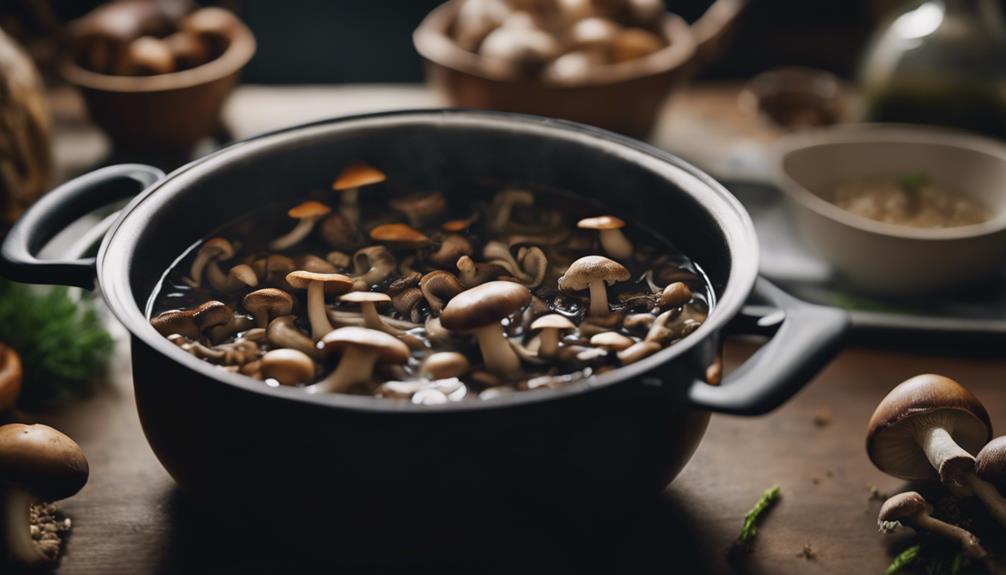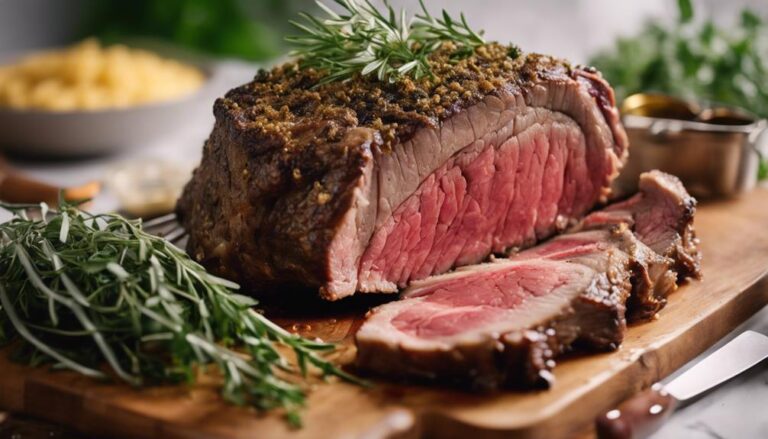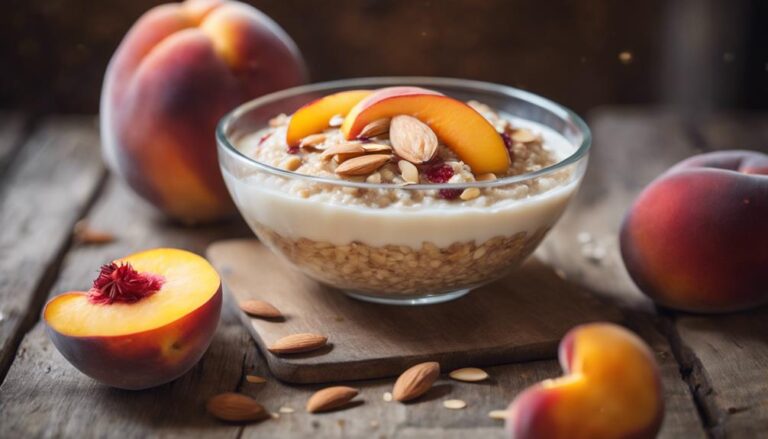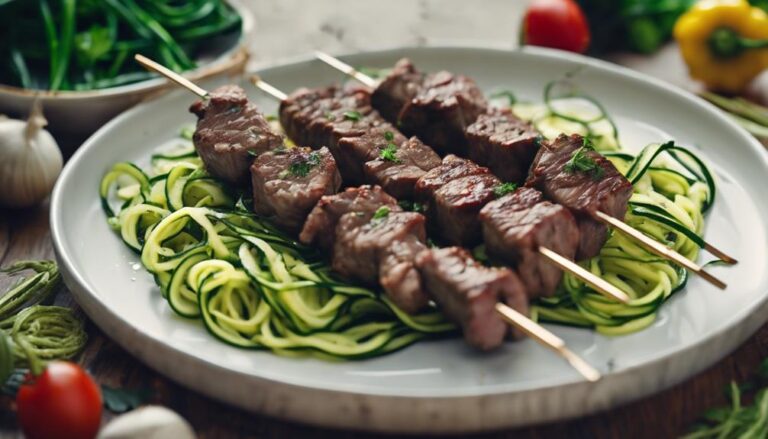Sous Vide Mushroom and Barley Stew
Immerse yourself in the tantalizing blend of earthy mushrooms and robust barley in this sous vide mushroom and barley stew. Let the flavors meld together as they cook to perfection in the precise sous vide method. Enjoy the tenderness of the mushrooms and the chewiness of the barley, enhanced by aromatic herbs and savory spices that lend a depth of flavor to this hearty stew. The rich broth intensifies the essence of this dish, creating a comforting and satisfying meal. Discover the culinary creativity behind combining mushrooms, barley, and herbs in this exquisite stew. Uncover the secrets to achieving a harmonious fusion of flavors and textures in every spoonful.
What You Will Learn Here
- Sous vide method enhances stew flavors and textures.
- Perfectly cooked mushrooms and barley in a rich broth.
- Infusing savory herbs and spices for depth of flavor.
- Slow cooking process for tender mushrooms and chewy barley.
- Experiment with ingredient combinations for a unique stew experience.
Mushroom Foraging Origins

When you venture into the lush forest or explore the depths of a meadow, you encounter a tapestry of mushroom habitats diversity waiting to be explored.
Understanding the history of foraging techniques can provide insights into the art and science of hunting for these elusive treasures.
The vast array of edible mushroom varieties found in nature beckons to be discovered and incorporated into culinary creations.
Mushroom Habitats Diversity
Amidst the lush undergrowth of forests and the damp earth of hidden clearings lie the diverse habitats where mushrooms thrive, each species uniquely adapted to its environment.
Mushroom biodiversity is a fascinating tapestry woven by evolution, showcasing how different species have specialized to inhabit specific niches. From the mycorrhizal relationships of forest-dwelling mushrooms to the saprotrophic nature of those found in decaying matter, each plays an essential role in their ecosystem.
Foraging techniques have evolved over time, shaped by the understanding of these habitats and the behaviors of various mushroom species. As you explore the rich tapestry of mushroom habitats, remember to tread lightly and respect the delicate balance that supports the diversity of these fascinating organisms.
Foraging Techniques History
Exploring the origins of mushroom foraging reveals a rich history intertwined with human curiosity and the quest for sustenance. Foraging techniques have evolved over centuries, from ancient civilizations gathering wild mushrooms for sustenance to the development of sustainable practices in modern times.
Historical foraging methods involved observing nature's cues, such as certain tree species or weather patterns, to locate edible fungi. These age-old practices laid the foundation for modern applications, where foragers combine traditional knowledge with scientific understanding to guarantee sustainability.
Edible Mushroom Varieties
Exploring the world of edible mushroom varieties reveals a diverse array of fungi with unique flavors, textures, and culinary uses. Popular varieties like button, cremini, and shiitake mushrooms are widely used in various dishes for their distinct tastes and textures.
Button mushrooms have a mild flavor, making them versatile for different cuisines, while cremini mushrooms offer a richer, earthier taste. Shiitake mushrooms add a savory, umami flavor to dishes and are commonly used in Asian cuisine. These mushrooms not only enhance the taste of dishes but also provide health benefits like boosting the immune system and improving heart health.
When cooking with mushrooms, remember to gently clean them with a damp cloth and avoid soaking them to maintain their texture and flavor.
Key Stew Components
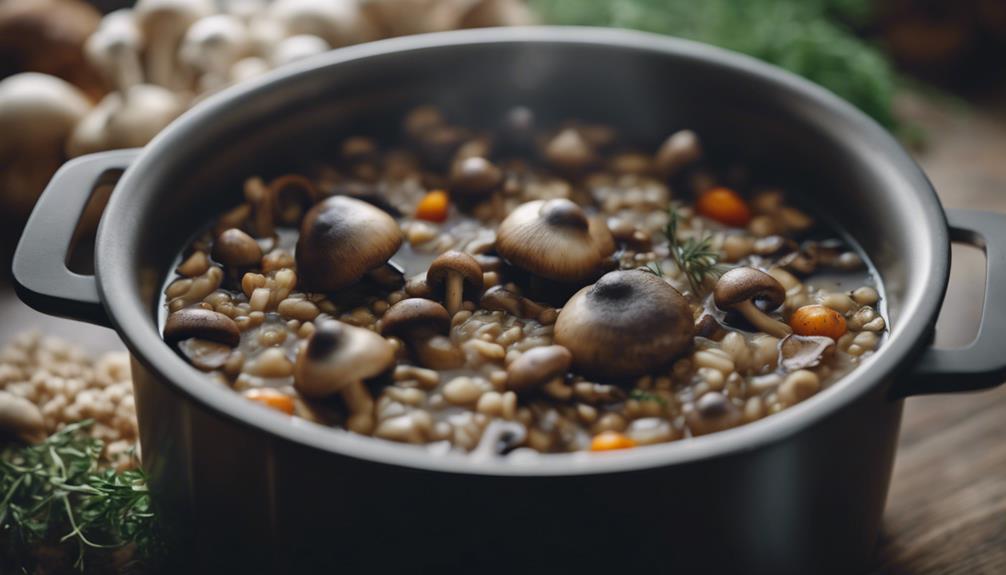
To craft a truly flavorful and satisfying mushroom and barley stew, focus on selecting the freshest ingredients and utilizing a variety of aromatic herbs and spices. Enhancing the stew's taste profile involves balancing flavors and textures to create a harmonious dish that delights the palate. When considering the key components of your stew, think about the following:
- Fresh Mushrooms: Choose a mix of edible mushroom varieties to add depth and richness to your stew.
- Pearl Barley: This hearty grain adds a chewy texture and nutty flavor, enhancing the stew's overall consistency.
- Aromatic Herbs: Incorporate herbs like thyme, rosemary, and bay leaves to infuse the stew with earthy and fragrant notes.
- Savory Spices: Utilize spices such as smoked paprika, cumin, and black pepper to elevate the stew's complexity and warmth.
- Rich Broth: Opt for a flavorful vegetable or mushroom broth as the base of your stew to intensify its savory essence.
Tried-and-Tested Stew Favorites
You'll find comfort in a bowl with these tried-and-tested stew favorites.
From a hearty lentil soup recipe that warms you from the inside out to a savory slow-cooked mushroom medley that bursts with rich flavors, these dishes have stood the test of time.
Let the earthy goodness of a mushroom and lentil stew transport you to a place of culinary satisfaction.
Hearty Lentil Soup Recipe
When making a tried-and-tested hearty lentil soup, consider starting with a medley of aromatic vegetables to enhance the depth of flavors in the stew.
Here are some tips to elevate your lentil soup game:
- Experiment with different lentil variations to find the texture and taste that suits your preference.
- Pair your soup with crusty bread or a side salad for a well-rounded meal.
- Play around with stew seasonings like cumin, smoked paprika, or fresh herbs to add complexity.
- Use a flavorful broth as the base for your soup to enhance its overall taste.
- Consider adding a splash of acidity with a squeeze of lemon or a splash of vinegar to brighten up the flavors.
Savory Slow-Cooked Mushroom Medley
Elevate your stew game with a rich and savory slow-cooked mushroom medley that promises a burst of flavors in every bite. This flavorful umami-packed mushroom medley will take your taste buds on a journey of pure delight. The earthy aroma and robust taste of the mushrooms will leave you craving more. Here are five reasons why this mushroom medley is a must-try:
- The combination of different mushroom varieties creates a complex depth of flavor.
- Slow cooking allows the mushrooms to release their juices, intensifying the taste.
- The medley pairs perfectly with hearty grains like barley or farro.
- It can be easily customized with herbs and spices to suit your preferences.
- Leftovers can be transformed into delicious sandwiches or omelets the next day.
Mushroom and Lentil Stew
Discover the comforting blend of earthy mushrooms and hearty lentils in this tried-and-tested Mushroom and Lentil Stew, a favorite among stew enthusiasts for its rich flavors and nutritious profile.
When preparing this stew, consider the following:
- Lentil Pairing: Lentils are the perfect companion to mushrooms, adding a depth of flavor and a creamy texture to the stew.
- Flavor Profile: The combination of savory mushrooms, earthy lentils, and aromatic seasonings creates a delicious umami-rich stew.
- Stew Seasoning: Balancing the flavors with a touch of garlic, thyme, and a hint of balsamic vinegar enhances the overall taste of the stew.
- Taste Balance: Adjust the salt and pepper levels carefully to achieve a harmonious balance of flavors that will satisfy your taste buds.
- Nutritious Elements: Packed with protein, fiber, and essential nutrients, this Mushroom and Lentil Stew not only delights the palate but also nourishes the body.
Stew Thickness Adjustment
When adjusting the thickness of your stew, it's essential to explore methods for thickening the consistency to your liking.
By focusing on adjusting the broth thickness, you can customize the stew's texture to meet your preferences.
Implementing textural enhancement techniques can elevate the overall dining experience and make your stew truly memorable.
Thickening Stew Consistency
To achieve the desired thickness in your Sous Vide Mushroom and Barley Stew, consider incorporating a roux made from equal parts of flour and fat.
The roux technique involves cooking the flour and fat together to form a paste that can be added to the stew as a thickening agent.
Another option is to create a cornstarch slurry by mixing cornstarch with water before adding it to the stew, ensuring a smooth consistency.
If you prefer a more natural thickening method, blending a vegetable puree into the stew can add both thickness and flavor.
To enhance the presentation, consider topping your stew with a sprinkle of bread crumbs for a delightful crunchy garnish.
These techniques will help you achieve the perfect stew consistency for a delightful dining experience.
Adjusting Broth Thickness
If you find that the broth in your Sous Vide Mushroom and Barley Stew is too thin or thick, adjusting its thickness can be easily achieved with a few simple techniques.
To perfect the broth consistency and maintain flavor balance, consider thickening options such as adding a cornstarch slurry or incorporating a roux mixture.
For a cornstarch slurry, mix equal parts cold water and cornstarch, then slowly stir it into the stew until reaching the desired thickness. Alternatively, a roux can be made by cooking equal parts flour and butter until golden, then whisking it into the stew.
Remember to allow the stew to simmer for a few minutes after adding thickeners to fully incorporate and adjust the seasoning as needed.
Serve this heartwarming stew with crusty bread or a side salad for a delightful meal.
Textural Enhancement Techniques
For an added depth of flavor and a more satisfying texture in your stew, consider incorporating textural enhancement techniques such as adjusting the stew thickness.
To achieve the ideal consistency, you can thicken your stew by using techniques like reducing the liquid or adding a roux made of flour and butter. Flavor pairing is essential in this process; for a heartier stew, consider using ingredients like tomato paste or miso paste to enhance umami flavors while contributing to a thicker texture.
Additionally, ingredient substitution can play a key role in adjusting stew thickness. For instance, replacing some of the broth with a pureed mixture of beans or vegetables can add richness and body to the stew without compromising flavor. Experiment with these techniques to create a stew that isn't only flavorful but also perfectly textured.
Final Thoughts
As you reflect on the rich flavors and textures of the Sous Vide Mushroom and Barley Stew, consider how the slow cooking process has enhanced the depth of each ingredient, creating a harmonious and satisfying dish that's sure to leave a lasting impression.
The culinary creativity involved in combining earthy mushrooms, hearty barley, and aromatic herbs in a sous vide preparation method has resulted in a stew that's both comforting and elegant.
The reflections on this dish may lead you to appreciate the tenderness of the mushrooms, the chewiness of the barley, and the way each ingredient retains its distinct flavor while melding together seamlessly. The slow cooking technique employed here allows for a gradual infusion of flavors, ensuring that every spoonful is a delight for the taste buds.
Frequently Asked Questions
Can This Stew Be Made Without Barley for a Gluten-Free Option?
For a gluten-free option, you can substitute barley with grain alternatives like quinoa, rice, or millet in the stew. These options will still provide a hearty texture and complement the flavors of the dish.
What Are Some Recommended Substitutions for Mushrooms in This Stew?
If you're looking for mushroom alternatives, consider using portobello or shiitake mushrooms for their meaty texture and umami flavor.
For a unique twist, try using diced eggplant or artichoke hearts to add a different dimension to the stew.
Vegetarian options like tofu or tempeh can also be great substitutes, providing protein and absorbing the rich flavors of the dish.
Experiment with these flavorful swaps to enhance your stew experience.
How Can I Make This Stew More Spicy or Flavorful?
To enhance the taste of your stew, consider adding spices like cayenne pepper, smoked paprika, or red pepper flakes for more heat.
You can also experiment with herbs like thyme, rosemary, or bay leaves for additional flavor depth.
Adjust the spice level based on your taste preferences by gradually adding small amounts and tasting as you go.
These simple tweaks can take your stew to the next level regarding spiciness and flavor.
Can I Freeze This Stew for Meal Prep Purposes?
Yes, you can freeze the stew for meal prep purposes. When considering freezing concerns, make sure to let the stew cool completely before portioning it into airtight containers or freezer bags.
This stew freezes well and can be stored for up to three months. When reheating, simply thaw it in the fridge overnight and then warm it up on the stovetop or microwave for a quick and convenient meal prep option.
Are There Any Special Tips for Reheating This Stew?
When reheating the stew, remember these tips for best flavor.
To enhance the taste, consider adding fresh herbs or a splash of balsamic vinegar.
To preserve the stew's texture, reheat slowly over low heat, stirring occasionally. Avoid boiling to prevent overcooking the ingredients.
Conclusion
Indulge in the rich flavors of this sous vide mushroom and barley stew, a dish that combines the earthy essence of foraged mushrooms with the hearty texture of barley.
With tried-and-tested stew favorites like carrots, onions, and garlic, this stew is a comforting and satisfying meal that will warm you from the inside out.
Adjust the thickness to your liking and savor every spoonful of this delicious and nutritious dish.
Bon appétit!
